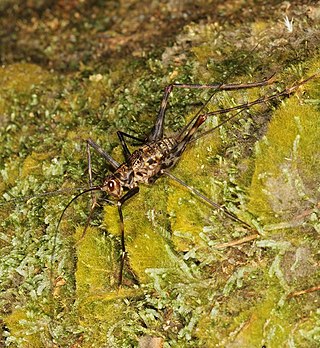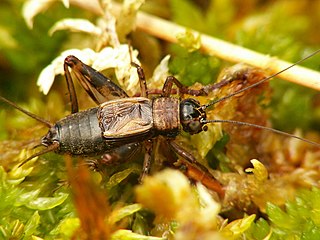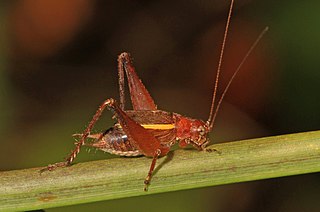
Gryllinae, or field crickets, are a subfamily of insects in the order Orthoptera and the family Gryllidae.

Trigonidiinae is a subfamily of insects in the order Orthoptera, suborder Ensifera, based on the type genus Trigonidium. They are often referred to as sword-tail crickets, winged bush crickets or trigs.

The Phaneropterinae, the sickle-bearing bush crickets or leaf katydids, are a subfamily of insects within the family Tettigoniidae. They are also known as false katydids or round-headed katydids.

Phalangopsinae, occasionally known as spider crickets, are a subfamily of crickets in the family Phalangopsidae. Members of Phalangopsinae are found worldwide in tropical and subtropical regions. Most species in the subfamily are nocturnal and can be found in rocky areas, near fallen wood, and the understory of forests. Some species are gregarious, gathering in large numbers.

The Eneopterinae are a subfamily of crickets, in the family Gryllidae, based on the type genus Eneoptera. It is one of several groups widely described as "true crickets", but this subfamily may also referred to in American English as "bush crickets". Of the more than 500 species that make up this subfamily, most occur in moist, tropical habitats. These insects are medium to large and brown or gray in color. They eat plant leaves, flowers, and fruits and can occasionally cause economic damage. Their eggs are deposited in pith, bark, or wood. Eneopterinae show a great diversity in stridulatory apparatus, signals emitted, and associated behaviour.

Nemobiinae is a subfamily of the newly constituted Trigonidiidae, one of the cricket families. The type genus is Nemobius, which includes the wood cricket, but members of this subfamily may also be known as ground crickets or "pygmy field crickets".
Hygronemobius is a genus of insects in the family Trigonidiidae.

Homoeogryllus is a genus of cricket in the subfamily Cachoplistinae and tribe Homoeogryllini. The recorded distribution is: Africa and Peninsular Malaysia.

The Hapithidi, previously placed as subfamily Hapithinae, is a supertribe of crickets in the family Oecanthidae and subfamily Podoscirtinae. It is one of several groups referred to in American English as "bush crickets", although this term can be confused with the Tettigoniidae.

Romaleinae is a subfamily of lubber grasshoppers in the family Romaleidae, found in North and South America. More than 60 genera and 260 described species are placed in the Romaleinae.

The Phylloscyrtini tribe is a group of 21 species of small crickets in the New World, from the eastern United States to Argentina. Little is known about their biology.

Podoscirtinae is a subfamily of crickets in the family Oecanthidae.

The Gryllotalpoidea are a superfamily of insects that includes the mole crickets and the ant crickets. The type genus is Gryllotalpa.

Phalangopsidae, which includes the "spider crickets" and their allies, is a reconstituted (2014) family of crickets, with the type genus Phalangopsis. Priority for family-group names based on this genus dates from Blanchard's "Phalangopsites".
The Phaloriinae is a subfamily of crickets of the family Phalangopsidae. Species are terrestrial and are distributed in: Africa, tropical Asia, Korea, Australia and the Pacific Islands.
Phalangopsis is a Neotropical genus of crickets in the family Phalangopsidae, subfamily Phalangopsinae, tribe Phalangopsini.
Cearacesaini is a tribe of crickets in the subfamily Hapithinae: found in North, Central, and South America. There are at least 4 genera and about 16 described species in Cearacesaini.

Gryllini is a tribe of crickets and typical of the family Gryllidae. Species are terrestrial, carnivorous or omnivorous and can be found in all continenents except Antarctica.

The Oecanthidae are a recently (2022) restored family of crickets based on the type genus OecanthusServille, 1831. They include "tree crickets", "anomalous crickets" and "bush crickets" and can be found in warmer parts of most of the world.

The Tafaliscinae are a subfamily of mostly Neotropical crickets in the recently restored family Oecanthidae and based on the type genus TafaliscaWalker, 1869. They can be found in warmer parts of the Americas and there is a species record from Java.















